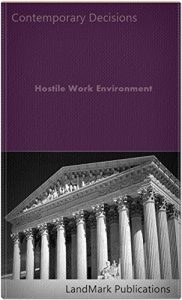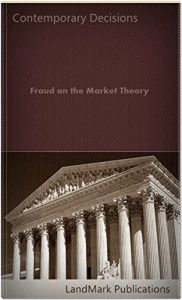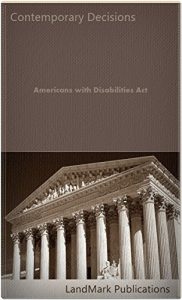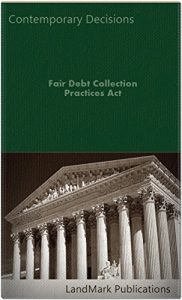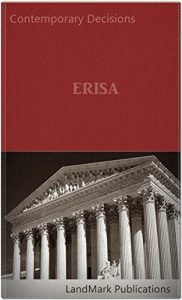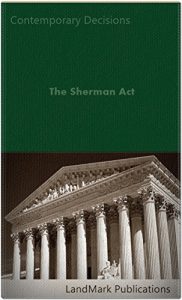THIS CASEBOOK contains a selection of 249 U. S. Court of Appeals decisions that discuss and analyze issues surrounding hostile work environment claims. The selection of decisions spans from 2004 to the date of publication.
In order to establish a claim of harassment or hostile work environment, a plaintiff must show: "(1) the plaintiff belongs to a protected group; (2) the plaintiff was subject to unwelcome harassment; (3) a causal nexus exists between the harassment and the plaintiff's protected group status; and (4) the harassment affected a term, condition, or privilege of employment." Gordon v. Shafer Contracting Co., 469 F.3d 1191, 1194-95 (8th Cir. 2006); see also Farmland Foods, Inc. v. Dubuque Human Rights Comm'n, 672 N.W.2d 733, 744 (Iowa 2003). Kelleher v. Wal-Mart Stores, Inc., (8th Cir. 2016).
A prima facie case of hostile work environment in violation of Title VII requires a plaintiff to show membership in a protected group, unwelcome harassment based on the protected characteristic, and "due to the harassment's severity or pervasiveness, the harassment altered a term, condition, or privilege of the plaintiff's employment and created an abusive working environment." Harsco Corp. v. Renner, 475 F.3d 1179, 1186 (10th Cir. 2007) (brackets and internal quotation marks omitted). Glapion v. Castro, (10th Cir. 2016).
Title VII, in addition to prohibiting discrimination that has direct economic consequences, forbids employers from requiring people to work in a discriminatorily hostile or abusive environment. Vance v. Ball State Univ., ___ U.S. ___, 133 S.Ct. 2434, 2440-41, 186 L.Ed.2d 565 (2013); Nichols, 755 F.3d at 600. When "the workplace is permeated with discriminatory intimidation, ridicule, and insult, that is sufficiently severe or persuasive to alter the conditions of the victim's employment and create an abusive working environment," Title VII is violated. Alexander, 739 F.3d at 982 (quoting Harris v. Forklift Sys., Inc., 510 U.S. 17, 21, 114 S.Ct. 367, 126 L.Ed.2d 295 (1993)). See also Hobbs, 573 F.3d at 464 ("Retaliatory harassment can rise to the level of a hostile work environment when it is severe enough to cause a significant change in the plaintiff's employment status."). Boss v. Castro, 816 F. 3d 910 (7th Cir. 2016).
Surviving summary judgment on a hostile work environment claim requires sufficient evidence demonstrating (1) the work environment was both objectively and subjectively offensive; (2) the harassment was based on membership in a protected class or in retaliation for protected behavior; (3) the conduct was severe or pervasive; and (4) there is a basis for employer liability. Nichols, 755 F.3d at 600 (quoting Alexander, 739 F.3d at 982). See also Knox v. Indiana, 93 F.3d 1327, 1334-35 (7th Cir.1996) (recognizing retaliatory hostile work environment theory). Though there is a paucity of caselaw on the matter, we see no reason retaliation-based actions by an employer must somehow be less objectively offensive than in the context of sex or race. See Burlington N. & Santa Fe Ry. Co., 548 U.S. at 68-69, 126 S.Ct. 2405; Gowski v. Peake, 682 F.3d 1299, 1312 (11th Cir.2012). We consider the hostile work environment claim under a "totality of the circumstances" approach. See Ellis, 650 F.3d at 647; Hall, 713 F.3d at 331 (courts should not carve up incidents of harassment then separately analyze each one). Boss v. Castro, ibid.
In order to establish a claim of harassment or hostile work environment, a plaintiff must show: "(1) the plaintiff belongs to a protected group; (2) the plaintiff was subject to unwelcome harassment; (3) a causal nexus exists between the harassment and the plaintiff's protected group status; and (4) the harassment affected a term, condition, or privilege of employment." Gordon v. Shafer Contracting Co., 469 F.3d 1191, 1194-95 (8th Cir. 2006); see also Farmland Foods, Inc. v. Dubuque Human Rights Comm'n, 672 N.W.2d 733, 744 (Iowa 2003). Kelleher v. Wal-Mart Stores, Inc., (8th Cir. 2016).
A prima facie case of hostile work environment in violation of Title VII requires a plaintiff to show membership in a protected group, unwelcome harassment based on the protected characteristic, and "due to the harassment's severity or pervasiveness, the harassment altered a term, condition, or privilege of the plaintiff's employment and created an abusive working environment." Harsco Corp. v. Renner, 475 F.3d 1179, 1186 (10th Cir. 2007) (brackets and internal quotation marks omitted). Glapion v. Castro, (10th Cir. 2016).
Title VII, in addition to prohibiting discrimination that has direct economic consequences, forbids employers from requiring people to work in a discriminatorily hostile or abusive environment. Vance v. Ball State Univ., ___ U.S. ___, 133 S.Ct. 2434, 2440-41, 186 L.Ed.2d 565 (2013); Nichols, 755 F.3d at 600. When "the workplace is permeated with discriminatory intimidation, ridicule, and insult, that is sufficiently severe or persuasive to alter the conditions of the victim's employment and create an abusive working environment," Title VII is violated. Alexander, 739 F.3d at 982 (quoting Harris v. Forklift Sys., Inc., 510 U.S. 17, 21, 114 S.Ct. 367, 126 L.Ed.2d 295 (1993)). See also Hobbs, 573 F.3d at 464 ("Retaliatory harassment can rise to the level of a hostile work environment when it is severe enough to cause a significant change in the plaintiff's employment status."). Boss v. Castro, 816 F. 3d 910 (7th Cir. 2016).
Surviving summary judgment on a hostile work environment claim requires sufficient evidence demonstrating (1) the work environment was both objectively and subjectively offensive; (2) the harassment was based on membership in a protected class or in retaliation for protected behavior; (3) the conduct was severe or pervasive; and (4) there is a basis for employer liability. Nichols, 755 F.3d at 600 (quoting Alexander, 739 F.3d at 982). See also Knox v. Indiana, 93 F.3d 1327, 1334-35 (7th Cir.1996) (recognizing retaliatory hostile work environment theory). Though there is a paucity of caselaw on the matter, we see no reason retaliation-based actions by an employer must somehow be less objectively offensive than in the context of sex or race. See Burlington N. & Santa Fe Ry. Co., 548 U.S. at 68-69, 126 S.Ct. 2405; Gowski v. Peake, 682 F.3d 1299, 1312 (11th Cir.2012). We consider the hostile work environment claim under a "totality of the circumstances" approach. See Ellis, 650 F.3d at 647; Hall, 713 F.3d at 331 (courts should not carve up incidents of harassment then separately analyze each one). Boss v. Castro, ibid.
